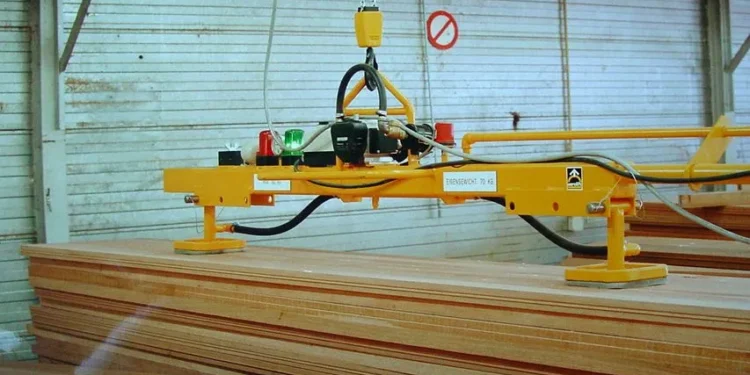In today’s fast-paced industrial landscape, efficiency, safety, and precision are no longer optional—they are essential. As industries evolve to meet increasing production demands, one technology stands out for its versatility and effectiveness: vacuum material handling. This innovative system has revolutionized how materials are moved, lifted, and positioned across various sectors, including manufacturing, logistics, pharmaceuticals, electronics, and food processing.
But what exactly is vacuum material handling, and what scientific principles make it so effective? In this article, we’ll explore the core mechanics, key components, and real-world applications of this technology, revealing why it has become indispensable in modern industries.
What Is Vacuum Material Handling?
Vacuum material handling refers to the process of using vacuum-based suction systems to lift, move, and manipulate materials without the need for mechanical clamping, gripping, or manual labor. It utilizes negative air pressure (vacuum) to create a lifting force, allowing objects to be securely and safely transported from one point to another.
This method is especially valuable for handling items that are fragile, awkward in shape, heavy, or difficult to grasp using traditional equipment.
The Physics Behind Vacuum Lifting
The science of vacuum material handling relies on basic principles of air pressure. At sea level, atmospheric pressure is approximately 101.3 kPa (kilopascals). When a vacuum is created in a closed space beneath a suction pad, the atmospheric pressure above the object becomes greater than the pressure below. This difference in pressure effectively pushes the object upward, enabling it to be lifted.
The amount of force generated depends on:
- The surface area of the suction pad
- The level of vacuum achieved
- The weight and porosity of the object
For example, a vacuum lifter with a larger suction cup and a strong vacuum source can lift heavier loads. This fundamental principle allows vacuum systems to handle everything from lightweight cardboard boxes to heavy metal sheets.
Core Components of a Vacuum Material Handling System
To understand the complete operation, it’s important to break down the major components involved in vacuum material handling systems:
1. Vacuum Generators
These create the necessary negative pressure and can be powered by electric, pneumatic, or mechanical means. Common types include:
- Ejector-based vacuum pumps
- Rotary vane pumps
- Venturi systems
2. Suction Pads or Cups
Made from rubber, silicone, or other flexible materials, suction pads are the contact points that seal onto the surface of the object being handled.
3. Control Valves
These regulate the flow of air and allow for precision in lifting, releasing, or moving the object. Some systems also include sensors to monitor pressure levels and ensure safety.
4. Lifting Mechanism or Frame
Depending on the size and complexity of the system, this can be a robotic arm, a gantry crane, or a simple hoist attached to a jib or overhead rail.
5. Filters and Safety Systems
To prevent contaminants or dust from damaging the vacuum pump, filters are used. Safety valves ensure that, in the event of a power failure, the object doesn’t fall immediately.
Advantages of Vacuum Material Handling
The widespread adoption of vacuum material handling technology is due to the numerous benefits it offers across industries:
1. Non-Contact Handling
Because the object is held via suction, there is no need for mechanical clamps or hooks, which reduces the risk of surface damage—critical for glass, electronics, or coated materials.
2. Ergonomic Benefits
These systems reduce the physical strain on workers, minimizing the risks of musculoskeletal injuries. Manual lifting of heavy or repetitive loads is replaced by user-friendly vacuum-assisted systems.
3. Speed and Efficiency
Vacuum material handling systems can operate faster than traditional methods, improving throughput and minimizing downtime, especially in automated environments.
4. Versatility
They can be adapted to a wide range of products—flat, curved, porous, or non-porous. Interchangeable suction pads make them suitable for various production lines.
5. Cleanroom Compatibility
Vacuum systems are ideal for sterile environments, such as pharmaceutical or food processing industries, because they do not involve lubricants or mechanical friction that can cause contamination.
Applications in Modern Industries
Vacuum material handling is not limited to one sector—it plays a crucial role in a variety of industrial settings:
Manufacturing and Assembly
In the automotive and aerospace sectors, vacuum lifters handle metal sheets, windscreens, and delicate assemblies. They help improve safety and reduce handling damage.
Logistics and Warehousing
Vacuum lifting systems are used to palletize goods, stack boxes, and load/unload shipments. They streamline warehouse operations and reduce human labor costs.
Glass and Window Industry
Large glass panes are lifted and installed using vacuum systems to avoid cracking or scratching. This is especially important for custom-fitted architectural projects.
Food and Beverage
In these highly regulated environments, vacuum handling is used for packaging, handling raw materials, and moving sealed containers without contamination risks.
Electronics
Vacuum lifters safely handle delicate components like circuit boards and wafers that require ultra-clean, precise handling.
Challenges and Considerations
Despite the advantages, there are some limitations and considerations in implementing vacuum material handling systems:
- Surface Requirements: Porous or uneven surfaces can reduce vacuum holding power.
- System Maintenance: Regular inspection of seals, valves, and pumps is critical to ensure reliable operation.
- Initial Investment: High-quality systems can be expensive, though the ROI is typically strong through improved efficiency and safety.
Proper planning, including a detailed needs assessment and surface compatibility analysis, is essential before implementing vacuum material handling solutions.
Conclusion
As industries push for greater automation, safety, and productivity, vacuum material handling stands out as a proven and versatile solution. Its scientific foundation, rooted in the physics of air pressure, enables the lifting and manipulation of materials with unmatched precision and care.
















